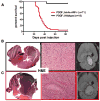Preclinical evaluation of radiation and perifosine in a genetically and histologically accurate model of brainstem glioma
- PMID: 20197468
- PMCID: PMC3831613
- DOI: 10.1158/0008-5472.CAN-09-2503
Preclinical evaluation of radiation and perifosine in a genetically and histologically accurate model of brainstem glioma
Abstract
Brainstem gliomas (BSG) are a rare group of central nervous system tumors that arise mostly in children and usually portend a particularly poor prognosis. We report the development of a genetically engineered mouse model of BSG using the RCAS/tv-a system and its implementation in preclinical trials. Using immunohistochemistry, we found that platelet-derived growth factor (PDGF) receptor alpha is overexpressed in 67% of pediatric BSGs. Based on this observation, we induced low-grade BSGs by overexpressing PDGF-B in the posterior fossa of neonatal nestin tv-a mice. To generate high-grade BSGs, we overexpressed PDGF-B in combination with Ink4a-ARF loss, given that this locus is commonly lost in high-grade pediatric BSGs. We show that the likely cells of origin for these mouse BSGs exist on the floor of the fourth ventricle and cerebral aqueduct. Irradiation of these high-grade BSGs shows that although single doses of 2, 6, and 10 Gy significantly increased the percent of terminal deoxynucleotidyl transferase-mediated dUTP nick end labeling (TUNEL)-positive nuclei, only 6 and 10 Gy significantly induce cell cycle arrest. Perifosine, an inhibitor of AKT signaling, significantly induced TUNEL-positive nuclei in this high-grade BSG model, but in combination with 10 Gy, it did not significantly increase the percent of TUNEL-positive nuclei relative to 10 Gy alone at 6, 24, and 72 hours. Survival analysis showed that a single dose of 10 Gy significantly prolonged survival by 27% (P = 0.0002) but perifosine did not (P = 0.92). Perifosine + 10 Gy did not result in a significantly increased survival relative to 10 Gy alone (P = 0.23). This PDGF-induced BSG model can serve as a preclinical tool for the testing of novel agents.
Figures





References
-
- Hargrave D, Bartels U, Bouffet E. Diffuse brainstem glioma in children: critical review of clinical trials. Lancet Oncol. 2006;7:241–8. - PubMed
-
- Guillamo JS, Monjour A, Taillandier L, et al. Brainstem gliomas in adults: prognostic factors and classification. Brain. 2001;124:2528–39. - PubMed
-
- Broniscer A, Laningham FH, Sanders RP, Kun LE, Ellison DW, Gajjar A. Young age may predict a better outcome for children with diffuse pontine glioma. Cancer. 2008;113:566–72. - PubMed
-
- Leach PA, Estlin EJ, Coope DJ, Thorne JA, Kamaly-Asl ID. Diffuse brainstem gliomas in children: should we or shouldn't we biopsy? Br J Neurosurg. 2008;22:619–24. - PubMed
-
- Puputti M, Tynninen O, Sihto H, et al. Amplification of KIT, PDGFRA, VEGFR2, and EGFR in gliomas. Mol Cancer Res. 2006;4:927–34. - PubMed
Publication types
MeSH terms
Substances
Grants and funding
LinkOut - more resources
Full Text Sources
Other Literature Sources
Medical
Molecular Biology Databases
Miscellaneous

